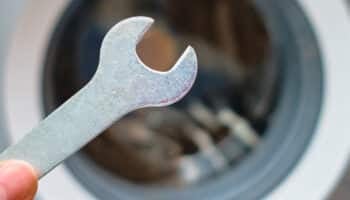We've independently reviewed this article to make sure it's as accurate as we can make it.
To find out more about our article creation and review process, check out our editorial guidelines.
If your dryer’s heat sensor is malfunctioning, you might be experiencing issues like:
- Overheating, potentially leading to a fire hazard
- Inadequate drying due to insufficient heat
- Damage to clothes due to excessive heat
- Increased energy consumption due to inefficient operation
- Frequent automatic shutdowns or failure to start the dryer
In my experience, the heat sensor in a dryer is a fairly simple repair to do yourself. A replacement can cost between $5 to $15, depending on your dryer brand and model.
In this guide, I’ll walk you through fixing your heat sensor issue in one of three ways:
- Fixing the issue yourself
- Get one-to-one help with an expert online
- Find a local pro who can solve the issue for you.
If that sounds good, then let’s get started.
Why trust us? This article was written by Craig Anderson and James Blackford.
Craig has helped thousands of other homeowners repair their appliances since 2016.
James is one of our resident appliance experts with over 16 years of experience. He currently works as a Master Technician for SquareTrade, and runs his own appliance repair business.
Option 1: Fixing It Yourself
If you want to replace the heat sensor yourself, then I’m sure you can do it! It might take rolling up your sleeves and some hard work, but you’ll save yourself some money and learn more about your appliance along the way.
Need a replacement part? I highly recommend our partners at AppliancePartsPros. Just enter your model number into the search bar below to see if they have a replacement heat sensor in stock, and the price.

Keep reading down to the DIY section below to find a helpful video and written guide on diagnosing and repairing your heat sensor.
Option 2: Get One-To-One Advice
Everything is online these days – even expert appliance advice.
For a small trial fee, our partner at JustAnswer can put you in touch with a repair expert. You can text or call them, send them videos and photos, and generally get just an expert opinion on how to fix your specific issue.
If you need a replacement part, they’ll even find you the exact one you need.
To get in touch with an expert, just use the chat box below.
Option 3: Hire A Pro To Fix Your Dryer
If you’d prefer to hire a professional, I’d expect to pay around $120 to $220 for a repair. Make sure to check out our guide on how to find a repair professional you can trust.
DIY Repair Guide – Inspect & Replace a Dryer’s Heat Sensor
Moving on to the DIY repair guide.
If you’d rather watch instead of read, our partners at AppliancePartsPros have a fantastic video on fixing a broken dryer heat sensor. This one is for a Frigidaire dryer, but the general process works for almost every dryer:
If you’d prefer a text guide, then read on!
Troubleshooting A Dryer Heat Sensor
If you suspect that your dryer’s heat sensor is malfunctioning, we first need to diagnose it.
1. Preparation
– Unplug the dryer from the electrical outlet to ensure safety.
– Locate the heat sensor. It is typically found on the heating element housing or the blower housing.
2. Accessing the Heat Sensor
– Remove the back panel of the dryer using a screwdriver.
– Identify the heat sensor. It is a small metallic piece attached to the heating element or blower housing.
3. Inspecting the Heat Sensor
– Check the heat sensor for any visible signs of damage such as burns, cracks, or discoloration.
– Ensure the heat sensor is securely attached and not loose.
4. Testing the Heat Sensor
– Use a multimeter to test the heat sensor. Set the multimeter to the lowest ohm setting.
– Touch one probe to each terminal on the heat sensor. A functioning heat sensor should give a reading of zero or close to zero.
5. Final Steps
– If the heat sensor does not pass the multimeter test, it may need to be replaced.
– Once inspection is complete, remember to replace the back panel of the dryer.
If it looks like the heat sensor is busted, we’ll need to replace it with a new one.
For replacement parts, just find your model number and enter it into the search bar below.

The search bar will take you to my favorite parts supplier – AppliancePartsPros. They cover almost every part with low prices, fast delivery, and amazing customer support. They’re my #1 supplier when I need a new part.
Replacing Your Dryer’s Heat Sensor
If you’re confident that the heat sensor needs to be replaced, then let’s get to work on swapping it out.
6. Replacing the Heat Sensor
– Purchase a new heat sensor that is compatible with your dryer model.
– Remove the faulty heat sensor by unscrewing it from the heating element or blower housing.
– Install the new heat sensor by screwing it into the same spot where the old one was located.
7. Reassembling the Dryer
– Once the new heat sensor is securely in place, it’s time to reassemble the dryer.
– Replace the back panel of the dryer by aligning it with the dryer frame and tightening the screws.
– Ensure all screws are tightened and the back panel is secure.
8. Testing the Dryer
– Plug the dryer back into the electrical outlet.
– Run a drying cycle to ensure the dryer is heating properly and the new heat sensor is functioning correctly.
9. Final Inspection
– After the test run, unplug the dryer and remove the back panel once more.
– Inspect the new heat sensor to ensure it is still securely attached and shows no signs of damage.
– If everything looks good, replace the back panel and plug the dryer back in.
10. Regular Maintenance
– To prolong the life of your dryer and its components, perform regular maintenance checks.
– Clean the lint filter after every use and inspect the heat sensor periodically to ensure it’s functioning correctly.
And that should do it!
If this guide has helped you solve your heat sensor issue, that’s fantastic! I’d love to hear about it via our contact page.
Still Stuck? It Might Be Time To Call In A Pro
If you’ve gotten stuck during the process, sometimes it’s best to call in reinforcements.
For asking questions and getting guidance from an expert, you can always use the JustAnswer chat near the top of this article to connect with a pro one-on-one.
Or if you’d prefer someone to come out and fix your Dryer for you, make sure to check out our guide to finding a repair pro you can trust.
I hope this guide has helped you fix your dryer’s heat sensor!
Be sure to check out our Dryer Best Practices guide for some easy tips and tricks that will help you prevent future issues and get your dryer working even better.







